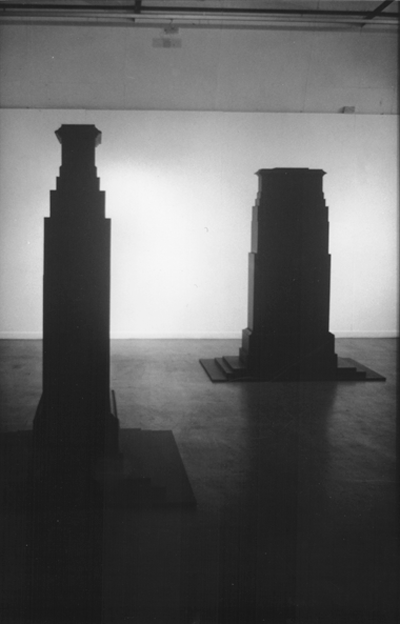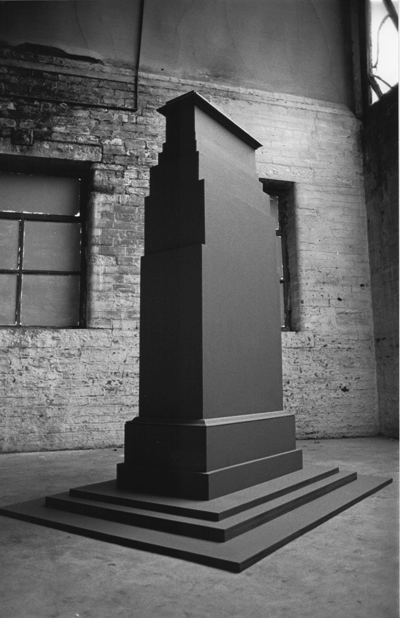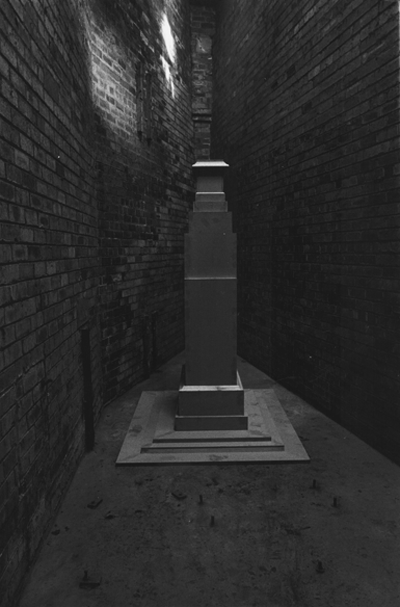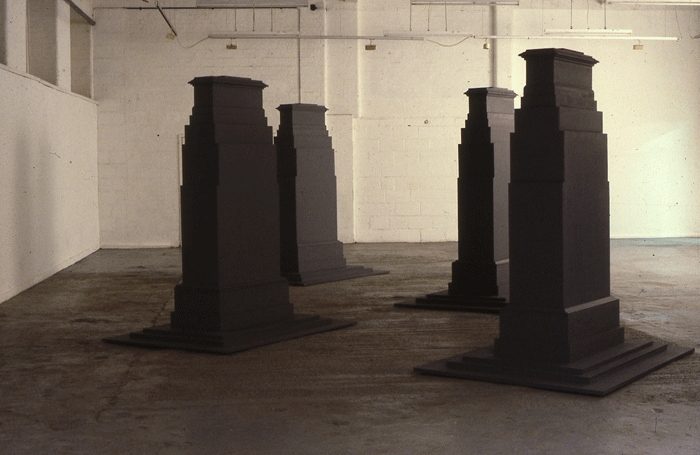



The Cenotaph Project 1987-1991
Stuart Brisley and Maya Balcioglu
in January 1987 Stuart Brisley was appointed to a six months residency at the Imperial War Museum in London. IWM collection contained a model of the Whitehall Cenotaph in a glass case. Complete with flags the model displays all the precision and intensity peculiar to architectural models.
It slowly came to mind that the Cenotaph could become the subject of work. Subsequently Brisley discussed the idea with Maya Balcioglu, and as a result the project was developed on a collaborative basis.
The Project:
For each venue, one Cenotaph model was made.
At each successive venues multiplied models were shown together, in addition to the one made specifically for that presentation.
The first Cenotaph model was built to be shown in a council flat in St.Cuthbert’s village in Gateshead, Newcastle. The standard ceiling height for council flats is 7’6’’. The first Cenotaph was built to the height of 7’3.5”. All subsequent models were identical in size. At this height the models are approximately 1/5 scale of the Whitehall Cenotaph.
The original monument is an imposing edifice. A monolithic, hierarchic verticality, commanding and undecorated, it sits in the middle of a main road at the heart of the offices of the British government with a considerable space around it and contains no sacred relics inside.
The monument stands empty.
Same qualities are retained in the 1/5 representation, but when a number of these are placed together the sense of form, space, history, purpose and meaning is fractured.
The Cenotaph becomes a found object.
The multiple scale copies of the Cenotaph are not reproductions and when brought together do not congeal to make a final statement. Purpose of the multiplicity of representation is to simultaneously activate and break through the structure, to deconstruct the edifice and make a modest proposal: The possibility of change. The Cenotaph Project seeks out breaks, slippages, spills, contradictions and vertiginous moments within predetermined ideological discourses by which we are constituted. The restlessness of deconstruction is drawn into the work as an active cultural strategy refusing to remain still. Horizontal landscaping of the Cenotaph Project is reflected elsewhere, where it has continually reached over, out and beyond itself connecting to dimensions located outside the framework of a limited and controlled engagement.
The Colour of the Copy:
Initially painted grey, colour of the Cenotaphs slowly changed from location to location. At the sixth, one Cenotaph was isolated, placed in low light and painted almost white while the other five, in close association graduated in colour until the sixth which was painted a strong mid-tone poppy red and placed in strong light (Chapter Arts Centre, Cardiff).
Colour was used as a silent carrier of emotion and a binding agent between object and language: the text on the Cenotaph resurfaced in every location on the walls of the installations. This time, as a critique of official history.
The Horizontal Monument:
Public meetings were held at each installation to acknowledge the temporal, changing nature of the proposal. At each location, meetings were organised drawing into collective debate both meanings arising immediately out of the presence of the Cenotaph, but also a wider contextualising of ideas relating to contemporaneous issues were discussed.
After the installation at the last regional venue, Derry in Northern Ireland, the final form of the project took the shape of a publication, standing as the final collective expression.
The Incomplete Work:
The Cenotaph Project stands complete – that is to say that the work comprising the six Cenotaph models and the narration of this stage of the Project has been done.
However, the deconstructive process remains active, for both the external (objective) history that has created the Cenotaph and the internal (subjective) histories that are attached to and reflected upon it are not final – an end in this sense would mean the end of history, a terrifying prospect.
The Cenotaph Project remains inconclusive, scandalous and flamboyant to some in its proposition to think the unthinkable, and unsatisfactory for those who insist upon definitive endings.
The Cenotaph Project is above all an art work, a sculpture looking at its own meaning and production, a vessel of its own undoing.
The monument stands mute.
The Chronology:
St Cuthbert’s Village, Gateshead, March-April 1987
Kettle’s Yard Gallery, Cambridge, May 1987
Jura Building, Dean Clough, Halifax, October-November 1987
Chisenhale Gallery, London, December 1987
Aspex Gallery, Portsmouth, June 1988
Pearce Institute, Govan, Glasgow, July-August 1988
Chapter Arts Centre, Cardiff, November-December 1988
Orchard Gallery, Derry, November-December 1989
Maya Balcioglu, 2012